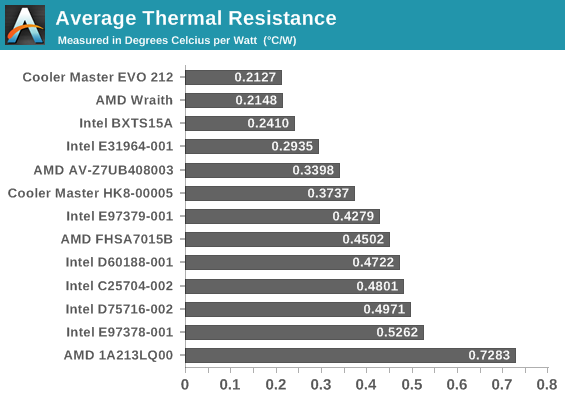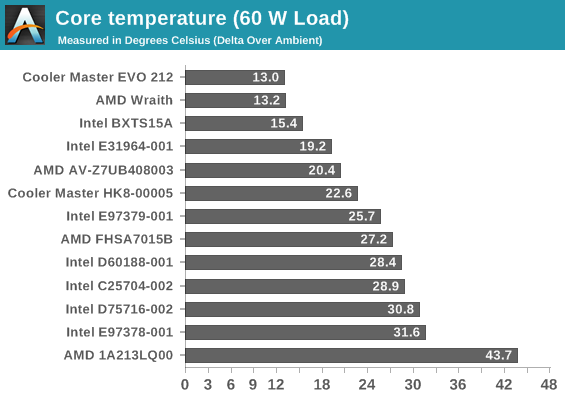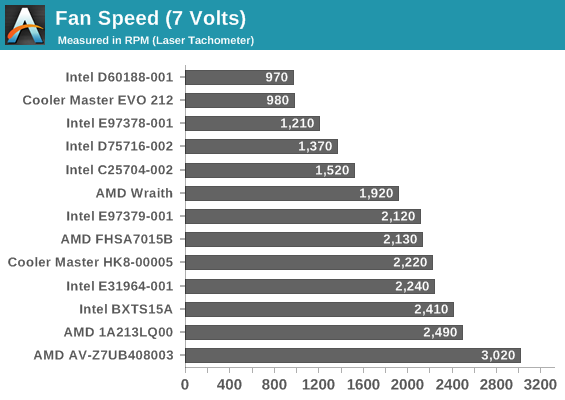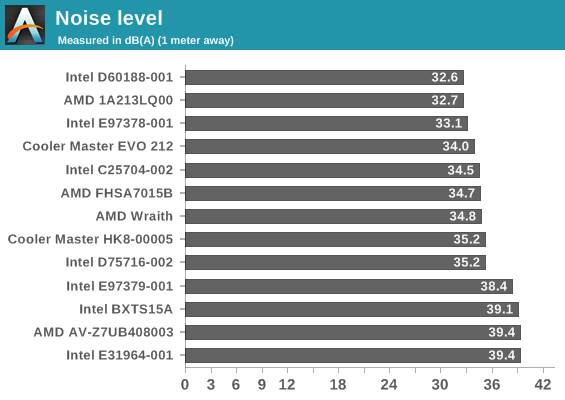Battle of The CPU Stock Coolers! 7x Intel vs 5x AMD, plus an EVO 212
by E. Fylladitakis on July 22, 2016 9:00 AM EST- Posted in
- Cases/Cooling/PSUs
- CPUs
- AMD
- Intel
- Cooler Master
- Cooler
Testing Results, Low Fan Speed (7 Volts)
Intel’s E97379-001 and AMD’s AV-Z7UB408003 coolers are equipped with automatic speed correction circuitry and adjust their speed to the maximum regardless of the input voltage. This renders the majority of basic fan controllers, rheostats and simple fan speed reduction resistors useless. Their speed can only be controlled via a PWM signal from a motherboard. The E97379-001 did have a small speed drop with an input of 6.5V and we included those results, but the AV-Z7UB408003 was rather adamant and devoid of a PWM signal would always automatically correct its speed to 3000 RPM, giving us the exact same performance results as before.

Again, the three most powerful coolers take the top spots at reduced power.

| Core Temperature, Constant Thermal Load (Low Fan Speed) |
Similarly to the 12V results, the EVO, Wraith and BXTS15A are taking the top spots. It's useful to note that EVO 212 and the Wraith are essentially equal as the power increases, with the Wraith being marginally ahead at very high thermal loads.


Putting the two "abnormal" coolers with non-adjustable fan settings aside, the thermal performance of the other coolers decreased almost equally, leaving their standings untouched. The D75716-002 still performs similarly to the C25704-002 and the D60188-001, but the former still is the loudest and the latter still is the quietest of the three. As a matter of fact, the D75716-002 is louder than the C25704-002, even though the fan is slower, hinting that either the fan has a worse engine or the denser fins significantly increased the airflow resistance of the cooler.
We cannot compare the AV-Z7UB408003 cooler to the rest of AMD’s coolers due to the autocorrecting fan. Nevertheless, we can make a useful observation looking at the Cooler Master’s HK8-00005 performance. Despite it has a slightly lower mass compared to that of the FHSA7015B and virtually the same fan, its thermal performance is much better, showcasing how two simple heatpipes can significantly increase the efficiency of a cooler.
Once again, AMD’s Wraith goes directly head to head with Cooler Master’s EVO 212, only this time the Wraith also compares in terms of acoustic comfort. There is virtually no difference between the two coolers in terms of thermal performance and both are equally silent with their fan input voltage reduced down to 7 Volts. The Intel BXTS15A does compare in terms of thermal performance but falls significantly behind when it comes to acoustics, as the cooler remains clearly audible even with its fan’s speed reduced by nearly 40%.










82 Comments
View All Comments
yannigr2 - Friday, July 22, 2016 - link
Your comment makes you look stupidly indeed. A company is giving a top quality cooler that saves you $20-$30 and you find it stupidly sad?SetiroN - Friday, July 22, 2016 - link
Yes, I find the fact that the best thing a CPU manufacturer's got going is their bundled cooler extremely sad.yannigr2 - Saturday, July 23, 2016 - link
Some people will find sadness in everything AMD does. At the same time they will praise Nvidia or Intel for doing the exact same thing.DanNeely - Friday, July 22, 2016 - link
I disagree. While part of this demonstrates clearly what most of us already know; most stock coolers suck. It also shows that AMD actually did deliver a good stock cooler in the Wraith. Cooling wise it matches the budget standby Cooler Master 212; and comes close to matching it in terms of sound as well making it the first stock cooler I wouldn't automatically recommend trashing for an aftermarket job.If I were nit picking, I'd've liked to've seen an affordable non-tower aftermarket cooler in the mix as well because slim profile cases don't have room for big towers. OTOH by including a 212 in the mix this article can be used as a baseline to compare testing results on them elsewhere.
A5 - Friday, July 22, 2016 - link
Meh. If AT is going to get back in the CPU cooler review game, this is a good place to start for two reasons.1) Make sure they're starting from a good assumption (stock coolers suck).
2) Compare it to the current most popular replacement.
From there, you can start adding in higher-end coolers and comparing them to the baseline.
Ratman6161 - Friday, July 22, 2016 - link
I don't necessarily agree that "stock coolers suck". They suck for most of the people who would be reading this article in the first place :) but are generally more than adequate for people running their system at stock speeds and more or less typical conditions.I think Intel has essentially taken the right approach. Bundle a good enough cooler with most CPU's since they are adequate to the task and the people using them won't know the difference anyway. Sell the "K" CPU's without a cooler. If you are buying a K, then then you are probably also a person who wants to chose their own cooling solution too. Everybody wins.
JoeyJoJo123 - Friday, July 22, 2016 - link
Except in the latter case you're actually losing.They USED to bundle the stock cooler, and even if it wasn't used permanently, it was certainly useful for testing boot or as something to hold you over until you save another ~$100 for an all-in-one CLC that couldn't fit your initial PC budget.
I'd be all in if the lack of the stock cooler also meant they dropped prices on those same kinds of CPUs, but the prices actually went up AND they lost the stock cooler. Double loss for the consumer.
mikato - Thursday, July 28, 2016 - link
I bought non-K Intel CPUs (and AMD CPUs) and aftermarket coolers. Up to this point, I had useless stock coolers that NEVER got used since most of the time I bought a decent aftermarket cooler at the same time I build the computer. There is no point selling them on ebay. They were just an unfortunate waste of resources.So now I appreciate both strategies. Either don't include a cooler (and its price), or include a decent budget cooler (for less added price than a low-end aftermarket cooler). Both work for me. But as you say, if Intel hasn't passed on that cost saving then that isn't good.
It would be interesting to know how many people that build their own computers also use a non-stock CPU cooler (excluding the higher end Intel and AMD's Wraith). And how has that evolved over time since CPUs produce less heat now, and since budget coolers have improved quite a bit for their price.
To me water cooling is just plain unnecessary and has been for a long time. Air cooling does easily well enough, for less money, and less hassle. You don't get much for spending the extra money.
JonnyDough - Monday, August 1, 2016 - link
Best comment. I have about 18 desktop PCs, all of them from the last 6 years or so. Only one has a stock cooler and that's my HTPC, because it's so watt that it's quiet with the stock and sits in my living room far from me. I also think water cooling is a waste, when all one needs is a good cooler and some case fans. Water cooling nets just a few degrees difference in ambient case. If your VRMs are getting hot because the mobo maker didn't put a heatsink on it, just throw some cheap heatsinks on it.dishayu - Friday, July 22, 2016 - link
It IS useful. It helps put definite numbers to the theory that we already know to be true (that stock coolers suck). It tells users how much of a benefit they would get, going from their stock cooler to a 212 Evo (and subsequently other coolers they test in the future).This is good work, show some respect.